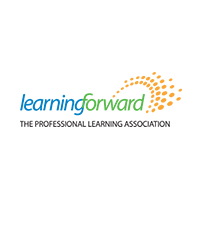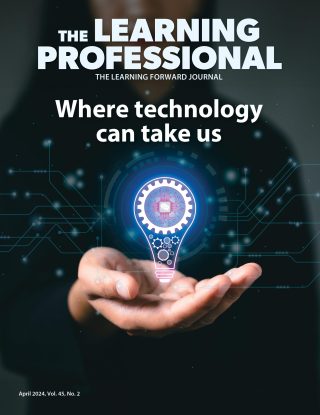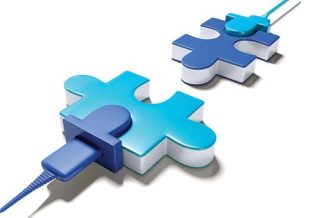Athletes, musicians, investors, and hopeless romantics search for the sweet spot in their equipment, analysis, or hearts. A sweet spot is a place where a combination of factors comes together to produce the best results with greatest
efficiency. William Safire, writing in his On Language column in The Times Magazine, says that “the origin of the metaphor is the thickest part of a baseball bat. That may not be subtle enough; more precisely, it is the place somewhere on the ‘meat end’ of the bat that the batter believes gives him the most power and control of placement. Or it is the place on the ball, just below the center of the sphere, that — when hit squarely to generate the proper amount of backspin — leads to the longest high drive” (Safire, 2007). As school systems around the world are increasing expectations for what students learn and what educators do to support their learning, they must aim for the sweet spot to achieve maximum results for their efforts.
Change Abounds
The pace and scope of change in schools provides many opportunities for missteps, wasted effort, and fragmentation. New standards, new accountability systems, new assessments, and new educator effectiveness systems consume the energy and focus of policymakers and educators. Each of these changes intends to provide each student with better education. By increasing the rigor and complexity of student learning, requiring authentic application of learning, and deepening and narrowing the range of content, educators intend to prepare all students for postsecondary education, careers, and participation in a global world. Educators have integrated into new content standards 21st-century skills such as critical and creative thinking, persistence, and problem-solving and workforce competencies such as communication, collaboration skills, change management, and personal awareness. Introducing new standards requires a change in how student learning experiences are designed to move the standards from a checklist of knowledge acquired to authentic, interdisciplinary applications of interdependent knowledge, skills, and dispositions that demonstrate achievement of the new standards.
Along with new content standards are new assessment systems that will provide both formative and summative measures of student progress. These assessments will make use of technology to provide timely, authentic, and informative data for educators and parents. In addition, there are new performance standards for educators. These standards clarify instructional and leadership expectations for effective educators and serve as the criteria for educator evaluation and professional growth. In the U.S., some states are implementing new accountability systems for student, school, and district performance, and realigning support and monitoring systems to ensure high levels of success for all students regardless of the school they attend.
Create Conditions for Learning
When student content standards and educator performance standards intersect and are surrounded with accountability and support systems that create the conditions for high degrees of educator and student learning, a sweet spot emerges for professional learning. In this sweet spot, educators have the best leverage for making one of the most important decisions about professional learning: its content and outcomes.
Effective professional learning requires a series of decisions. Among the most important is the content and outcomes of professional learning. Decisions about content and outcomes of professional learning are made based on multiple factors and by a variety of educators. Learning teams decide what they will learn and what they expect as a result of their learning. Individual educators consider their performance goals and current evaluation results to identify what they want to learn to improve performance. District and school leaders examine gaps in student learning to identify what educators need to know and do to fill those gaps.
The sweet spot evolves in the link that occurs among professional learning, educator performance standards, and student content standards. When its content integrates student learning standards and performance standards at the precise level of learning educators need, professional learning has the greatest potential to support educators in changing practices to increase student learning.
Numerous research studies and evidence in practice confirm that relationship between teacher practice and student learning. The Standards for Professional Learning (Learning Forward, 2011) guide educators to shape effective professional learning that meets the intended purpose: helping students perform at high levels (Cohen & Hill, 2000; Desimone, 2009; Garet, Porter, Desimone, Birman, & Yoon, 2001; Kennedy, 1998). The Outcomes standard states: Professional learning that increases educator effectiveness and results for all students aligns its outcomes with educator performance and student curriculum standards (Learning Forward, 2011). The standard makes explicit three essential elements: meeting educator performance standards, addressing student learning outcomes, and building coherence.
Educator Performance Standards
Educator performance standards typically delineate the knowledge, skills, practices, and dispositions of highly effective educators. These standards have multiple purposes, including guiding preparation programs, establishing licensing and certification requirements, defining components for induction programs, shaping expectations for workplace practices, and clarifying evaluation indicators.
When identifying what educators need to know and be able to do, performance standards make explicit what educators need to perform at high levels, meet career expectations, and impact student learning. Educators share common attributes with other professionals. Among them is the need and desire to engage in continuous learning to deepen and enrich knowledge, expand skills, refine dispositions, and add practices. Using performance standards to identify educator learning needs allows for professional learning planning that is more meaningful and laser-focused. See table above for examples of educator performance standards.
Collecting and analyzing data about educators’ backgrounds, learning preferences, teaching experience, and performance contribute to the development of more specific goals for professional learning. Performance data emerge from a variety of formative and summative processes, including self- and peer assessments, reflection, performance assessments, classroom walk-throughs and observations, and student and parent feedback.
All system and school staff — superintendent, principal, teacher, coach, counselor, and librarian — are held to specific standards that describe effective practice. Although educator performance standards (table above) are role-specific and vary across local, state, provincial, and national school systems and schools, what remains the same is an emphasis on effective practices that result in student learning.
These standards, frequently crafted through years of collaborative work among professionals, are often overlooked as the core content for professional learning. For teachers, this means that their professional learning may fail to support them to achieve expertise in the sophisticated knowledge, skills, and dispositions required of masterful, professional teachers. These areas include content knowledge; pedagogical content knowledge; respecting and addressing individual backgrounds, language, and academic abilities; differentiating learning to meet the needs of all learners; and general instructional pedagogy. The standards also include effective professional communication; collaborative teamwork; creating a collaborative culture; and garnering parental involvement. Professional learning that uses these standards as the content focus elevates practice by developing educators’ capacity to demonstrate the essential attributes of effectiveness. By integrating professional standards into professional learning, educators’ capacity to meet performance expectations is elevated and equity in teaching and learning is achieved.
Student Learning Outcomes
Student learning outcomes define the content knowledge and skills that every student is expected to achieve. These standards, along with performance standards, define the content of professional learning. Essentially, educators are accountable for supporting each student’s achievement of the outcomes. This means that educators must have deep understanding of the content area, the curriculum design, sequence, and development, and use content-specific instructional strategies to support student learning. In addition to understanding the complexities of teaching and learning, for example, teachers must understand how to teach math content in ways that model how students will be expected to demonstrate their learning in school and beyond.
Like educator performance standards, student learning outcomes define equitable expectations for all students to achieve at high levels. Deciding on the focus of professional learning begins with analyzing student learning needs in relation to the expected outcomes and clear goals for student achievement. With student learning goals in hand, educators can diagnose learning needs by asking the question: What do educators need to learn to do to support student achievement of their learning goals? The professional learning goal defines what educators need to know and be able to do to support high levels of student learning. The core content of professional learning is the intersection of what educators need to learn and do and what students need to learn and do. This process is the Backmapping Model for Planning Results-Based Professional Learning (Killion, 1999; Killion & Roy, 2009). The steps and key questions to consider for each step are outlined in the tool on p. 17. These questions will help educators structure discussions and reflections about each step.
Typically the depth, breadth, and developmental sequence of student learning outcomes can be found explicitly defined in subject and grade of student curriculum based on core academic standards. Periodically, local, state, provincial, and national education agencies adopt, revise and articulate standards, curriculum, instructional strategies, and assessments. In doing so, they specify expectations for student learning.
In the United States, most states have adopted new college- and career-ready standards. Adoption of these standards requires an extensive investment in professional learning to move standards into practice. This means that professional learning for all educators must be aligned to student learning outcomes to ensure full implementation of instructional practices and curriculum that ensure all students achieve the new standards. See table below for examples of student content standards.
Research has confirmed that a significant factor in raising academic achievement is the improvement of teachers’ instructional capacity in the classroom (Darling-Hammond, 1996; McLaughlin, 1993). Best practice also shows that educators who experience frequent, rich learning opportunities teach in more ambitious and effective ways (Rosenholtz, 1989; Wenger, 1998). To support all students in achieving defined learning outcomes, the content of professional learning must be designed to deepen educators’ content knowledge, understanding of how students learn in the disciplines, and the instructional methodologies that accelerate student learning in each discipline.
Building Coherence
In fiber optic communication, the term “coherence” describes the state in which waves are in phase with one another. This principle is the foundation of light wave transmission. When the waves are out of phase with one another, disruption in signals occurs. In similar fashion, many educators’ experiences in professional learning can be considered “noise” or disruption in signals because their learning experiences have been a collection of random, erratic, and fragmented activities. When there is a direct link among what students need to learn, what educators are expected to do, and the content and process of professional learning, educators appreciate the value of continuous improvement of their practices. When professional learning is leveraged as a systemic strategy, aligned to a comprehensive and coherent plan, it is more likely to be effective in improving educators’ knowledge, skills, and practices (Desimone, 2009; Garet, Porter, Desimone, Birman, & Yoon, 2001).
Alignment between educator and student learning builds coherence between the reality of what happens in an educator’s daily work and the development of his or her professional practices. It reinforces the belief that educators’ instructional and leadership abilities benefit student learning. It also builds on educators’ existing knowledge and skills, honors the individual talents they bring to learning experiences, their goals for career and performance development and their responsibility and accountability for reflecting on, refining, and adjusting their practice.
Coherence in professional learning occurs when an educator’s preparation program meshes seamlessly with career-long development. An educator continually expands the knowledge, skills, practices, and dispositions first developed in preparation programs through professional learning designed to help educators continue to grow in their content knowledge and pedagogical and leadership practices. A progression of learning eliminates fragmentation and competing priorities and increases the relevance and usefulness of learning. Ongoing, job-embedded professional learning and support for implementation at the individual, team, and school or district level strengthens communities of practice and reinforces collective responsibility and an educator’s sense of belonging and moral purpose (Fullan, 2007).
When its content integrates student learning standards and performance standards at the precise level of learning educators need, professional learning has the greatest potential to support educators in changing practices to increase student learning.
Deep Substantive Learning
From the triangulation of student learning goals, educator performance standards, and professional learning content emerges the sweet spot for both participants in and facilitators of professional learning. Combined, these three aspects create the ultimate sweet spot of professional learning. With a laser-like focus on the sweet spot, professional learning becomes more effective and efficient in promoting deep substantive learning that expands the length of an educator’s career. Firmly aligned with expectations defined in performance standards, professional learning generates the highest level of student learning outcomes.
Outcomes: Professional learning that increases educator effectiveness and results for all students aligns its outcomes with educator performance and student curriculum standards.
Examples of Educator Performance Standards
Examples of Student Content Standards
References
Cohen, D. & Hill, H. (2000). Instructional policy and classroom performance: The mathematics reform in California. Teachers College Record, 102(2), 294-343.
Darling-Hammond, L. (1996). The right to learn and the advancement of teaching: Research, policy, and practice for democratic education. Educational Researcher, 25(6), 5-17.
Desimone, L. (2009). Improving impact studies of teachers’ professional development: Toward better conceptualizations and measures. Educational Researcher, 38(3), 181-199.
Fullan, M. (2007). The new meaning of educational change (4th ed.). New York, NY: Teachers College Press.
Garet, M.S., Porter, A., Desimone, L., Birman, B., & Yoon, K.S. (2001, Winter). What makes professional development effective? Results from a national sample of teachers. American Educational Research Journal, 38(4), 915-945.
Kennedy, M. (1998, March). Education reform and subject matter knowledge. Journal of Research in Science Teaching, 35(3), 249-263.
Killion, J. (1999). What works in the middle: Results-based staff development. Oxford, OH: NSDC.
Killion, J. & Roy, P. (2009). Becoming a learning school. Oxford, OH: NSDC.
Learning Forward. (2011). Standards for Professional Learning. Oxford, OH: Author.
McLaughlin, M. (1993). What matters most in teachers’ workplace context? In J.W. Little & M.W. McLaughlin (Eds.), Teachers’ work: Individuals, colleagues, and contexts. New York, NY: Teachers College Press.
Rosenholtz, S. (1989). Teachers’ workplace. New York, NY: Longman.
Safire, W. (2007, April 1). On Language: Sweet spot. The Times Magazine. Available at www.nytimes.com/2007/04/01/magazine/01wwln-safire.t.html?fta=y.
Wenger, E. (1998). Communities of practice: Learning, meaning, and identity. Cambridge, Unnited Kingdom: Cambridge University Press.

Learning Forward is the only professional association devoted exclusively to those who work in educator professional development. We help our members plan, implement, and measure high-quality professional learning so they can achieve success with their systems, schools, and students.
Recent Issues
EVALUATING PROFESSIONAL LEARNING
February 2024
How do you know your professional learning is working? This issue digs...
TAKING THE NEXT STEP
December 2023
Professional learning can open up new roles and challenges and help...
REACHING ALL LEARNERS
October 2023
Both special education and general education teachers need support to help...
THE TIME DILEMMA
August 2023
Prioritizing professional learning time is an investment in educators and...











